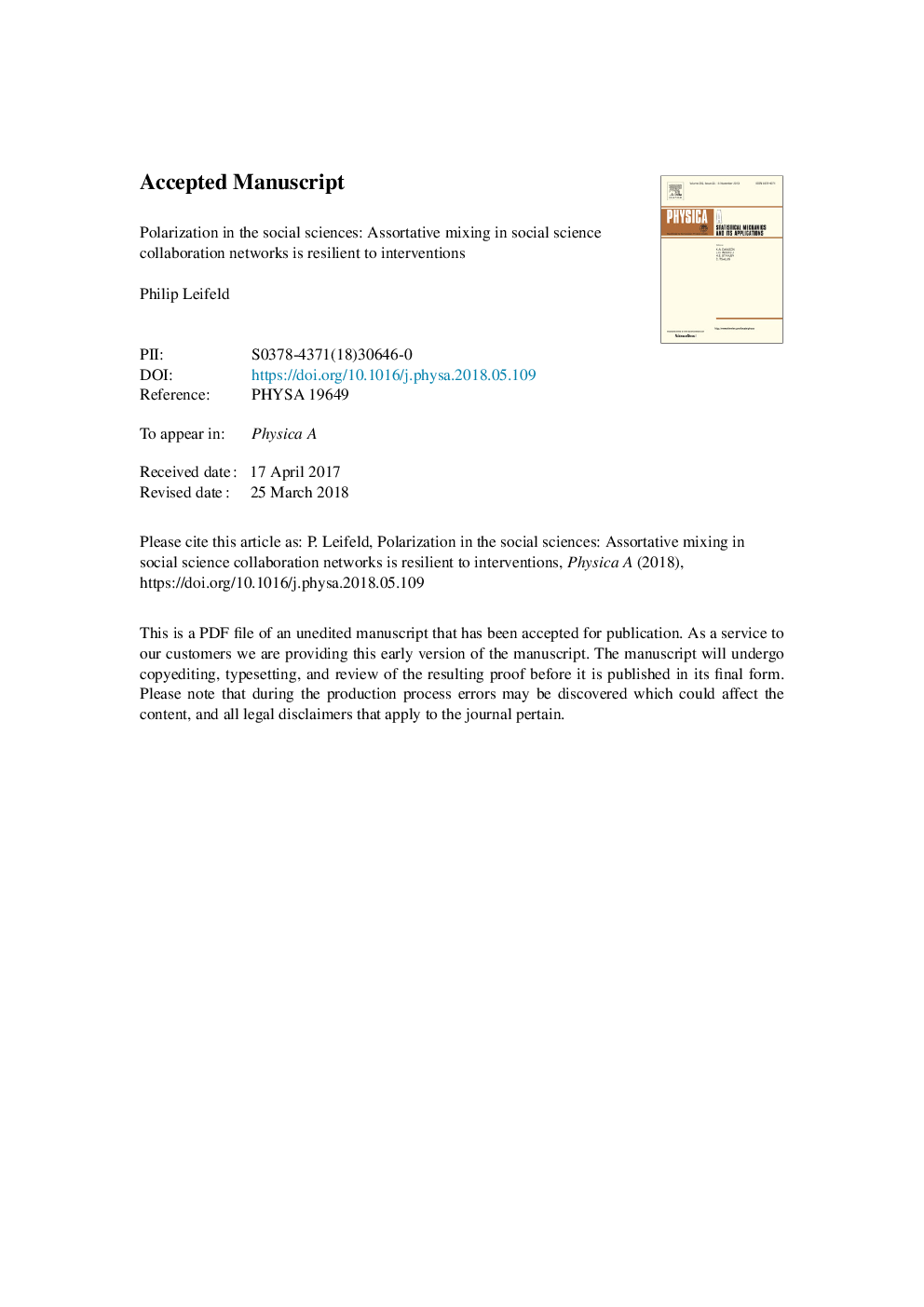| کد مقاله | کد نشریه | سال انتشار | مقاله انگلیسی | نسخه تمام متن |
|---|---|---|---|---|
| 7374958 | 1480066 | 2018 | 28 صفحه PDF | دانلود رایگان |
عنوان انگلیسی مقاله ISI
Polarization in the social sciences: Assortative mixing in social science collaboration networks is resilient to interventions
ترجمه فارسی عنوان
قطبش در علوم اجتماعی: مخلوطی کامل در شبکه های همکاری علمی اجتماعی، به مداخلات مقاوم است
دانلود مقاله + سفارش ترجمه
دانلود مقاله ISI انگلیسی
رایگان برای ایرانیان
کلمات کلیدی
همکاری علمی، شبکه همکاری قطبش، مخلوط آسفالت، مدل گرافیکی تصادفی دخالت شبکه، علوم اجتماعی،
ترجمه چکیده
همکاری علمی در علوم اجتماعی با قطبی شدن بین محققان هرمنوتیک و علم شناختی مشخص می شود. این قطبش در استراتژی های مختلف انتشار بیان شده است. در این مقاله، شبکه های کامل همکاری در یک رشته علوم اجتماعی در دو کشور جداگانه در طی پنج سال، با استفاده از یک مدل گرافیکی تصادفی نمونه ای تحلیل می شود. این بررسی می کند که آیا چگونگی ترکیب مخلوطی در استراتژی انتشار وجود دارد و منجر به قطبش در همکاری علمی می شود. در تجزیه و تحلیل تجربی، ترکیب مخلوط، نقش مهمی در شکل دهی شبکه ها دارد و به طور قابل توجهی همکاری را توضیح می دهد. لبه های همبستگی در هر یک از گروه ها شایع تر هستند، اما این الگوی مخلوط به طور کامل برای اندازه قطبی شدن به حساب نمی آید. در عوض، یک آزمایش فکر نشان می دهد که اجزای دیگر سیستم پیچیده، قطبش در روند تولید داده ها را تضعیف یا تقویت می کنند و مداخلات میکروسکوپی که تغییر رفتار هدفمند را در رابطه با جذابیت ایجاد می کنند، از طریق قابلیت انعطاف پذیری سیستم ها مانع می شود. مقاومت در برابر مداخلات در یک سری از شبیه سازی ها در اثر رفتار میکروسکوپی در قطبش ماکروسکوپی قابل اندازه گیری است. مطالعه تجربی برای نزدیک بودن جغرافیایی، نظارت و شباهت های موضعی (با استفاده از یک مدل فضای بردار) را کنترل می کند، و این درگیری از این عوامل احتمالا مسئول این انعطاف پذیری است. این مقاله همچنین شبکه همکاری نویسنده در یک کشور را بر اساس مدل همکاری در کشور دیگر پیش بینی می کند.
موضوعات مرتبط
مهندسی و علوم پایه
ریاضیات
فیزیک ریاضی
چکیده انگلیسی
Academic collaboration in the social sciences is characterized by a polarization between hermeneutic and nomological researchers. This polarization is expressed in different publication strategies. The present article analyzes the complete co-authorship networks in a social science discipline in two separate countries over five years using an exponential random graph model. It examines whether and how assortative mixing in publication strategies is present and leads to a polarization in scientific collaboration. In the empirical analysis, assortative mixing is found to play a role in shaping the topology of the network and significantly explains collaboration. Co-authorship edges are more prevalent within each of the groups, but this mixing pattern does not fully account for the extent of polarization. Instead, a thought experiment reveals that other components of the complex system dampen or amplify polarization in the data-generating process and that microscopic interventions targeting behavior change with regard to assortativity would be hindered by the resilience of the system. The resilience to interventions is quantified in a series of simulations on the effect of microscopic behavior on macroscopic polarization. The empirical study controls for geographic proximity, supervision, and topical similarity (using a vector space model), and the interplay of these factors is likely responsible for this resilience. The paper also predicts the co-authorship network in one country based on the model of collaborations in the other country.
ناشر
Database: Elsevier - ScienceDirect (ساینس دایرکت)
Journal: Physica A: Statistical Mechanics and its Applications - Volume 507, 1 October 2018, Pages 510-523
Journal: Physica A: Statistical Mechanics and its Applications - Volume 507, 1 October 2018, Pages 510-523
نویسندگان
Philip Leifeld,
